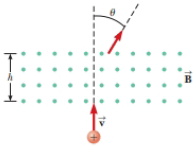
Concept explainers
Why is the following situation impossible? Figure P28.46 shows an experimental technique for altering the direction of travel for a charged particle. A particle of charge q = 1.00 μC and mass m = 2.00 × 10−15 kg enters the bottom of the region of uniform magnetic field at speed ν = 2.00 × 105 m/s, with a velocity vector perpendicular to the field lines. The magnetic force on the particle causes its direction of travel to change so that it leaves the region of the magnetic field at the top traveling at an angle from its original direction. The magnetic field has magnitude B = 0.400 T and is directed out of the page. The length h of the magnetic field region is 0.110 m. An experimenter performs the technique and measures the angle θ at which the particles exit the top of the field. She finds that the angles of deviation are exactly as predicted.
Figure P28.46

Trending nowThis is a popular solution!

Chapter 29 Solutions
EBK PHYSICS FOR SCIENTISTS AND ENGINEER
- A hydrogen atom has just a single electron orbiting the nucleus, which happens to be a single proton without any neutrons. The proton is positively charged, the electron negatively, but both with the same magnitude of charge given by e=1.602x10-19C. The mass of an electron is 9.11x10-31kg, and the proton is 1.67x10-27kg. Find the ratio of the electrostatic to the gravitational force of attraction between the electron and the proton in hydrogen. \arrow_forwardWhat is the third law pair to the normal force as you sit in a chair? What effect does the sun's pull on earth have in terms of third law pairs?arrow_forwardUsing Newton's 2nd law, show that all objects subject to the pull of gravity alone should fall at the same rate. What is that rate?arrow_forward
- No chatgpt pls will upvotearrow_forwardA cart on wheels (assume frictionless) with a mass of 20 kg is pulled rightward with a 50N force. What is its acceleration?arrow_forwardLight travels through a vacuum at a speed of 2.998 x 108m/s. Determine the speed of light in the following media: crown glass (n = 1.52)arrow_forward
- 2.62 Collision. The engineer of a passenger train traveling at 25.0 m/s sights a freight train whose caboose is 200 m ahead on the same track (Fig. P2.62). The freight train is traveling at 15.0 m/s in the same direction as the passenger train. The engineer of the passenger train immediately applies the brakes, causing a constant acceleration of 0.100 m/s² in a direction opposite to the train's velocity, while the freight train continues with constant speed. Take x = 0 at the location of the front of the passenger train when the engineer applies the brakes. (a) Will the cows nearby witness a collision? (b) If so, where will it take place? (c) On a single graph, sketch the positions of the front of the pas- senger train and the back of the freight train.arrow_forwardCan I get help with how to calculate total displacement? The answer is 78.3x-4.8yarrow_forward2.70 Egg Drop. You are on the Figure P2.70 roof of the physics building, 46.0 m above the ground (Fig. P2.70). Your physics professor, who is 1.80 m tall, is walking alongside the building at a constant speed of 1.20 m/s. If you wish to drop an egg on your profes- sor's head, where should the profes- sor be when you release the egg? Assume that the egg is in free fall. 2.71 CALC The acceleration of a particle is given by ax(t) = -2.00 m/s² +(3.00 m/s³)t. (a) Find the initial velocity Vox such that v = 1.20 m/s 1.80 m 46.0 marrow_forward
 Principles of Physics: A Calculus-Based TextPhysicsISBN:9781133104261Author:Raymond A. Serway, John W. JewettPublisher:Cengage Learning
Principles of Physics: A Calculus-Based TextPhysicsISBN:9781133104261Author:Raymond A. Serway, John W. JewettPublisher:Cengage Learning Physics for Scientists and EngineersPhysicsISBN:9781337553278Author:Raymond A. Serway, John W. JewettPublisher:Cengage Learning
Physics for Scientists and EngineersPhysicsISBN:9781337553278Author:Raymond A. Serway, John W. JewettPublisher:Cengage Learning Physics for Scientists and Engineers with Modern ...PhysicsISBN:9781337553292Author:Raymond A. Serway, John W. JewettPublisher:Cengage Learning
Physics for Scientists and Engineers with Modern ...PhysicsISBN:9781337553292Author:Raymond A. Serway, John W. JewettPublisher:Cengage Learning College PhysicsPhysicsISBN:9781305952300Author:Raymond A. Serway, Chris VuillePublisher:Cengage Learning
College PhysicsPhysicsISBN:9781305952300Author:Raymond A. Serway, Chris VuillePublisher:Cengage Learning College PhysicsPhysicsISBN:9781285737027Author:Raymond A. Serway, Chris VuillePublisher:Cengage Learning
College PhysicsPhysicsISBN:9781285737027Author:Raymond A. Serway, Chris VuillePublisher:Cengage Learning





